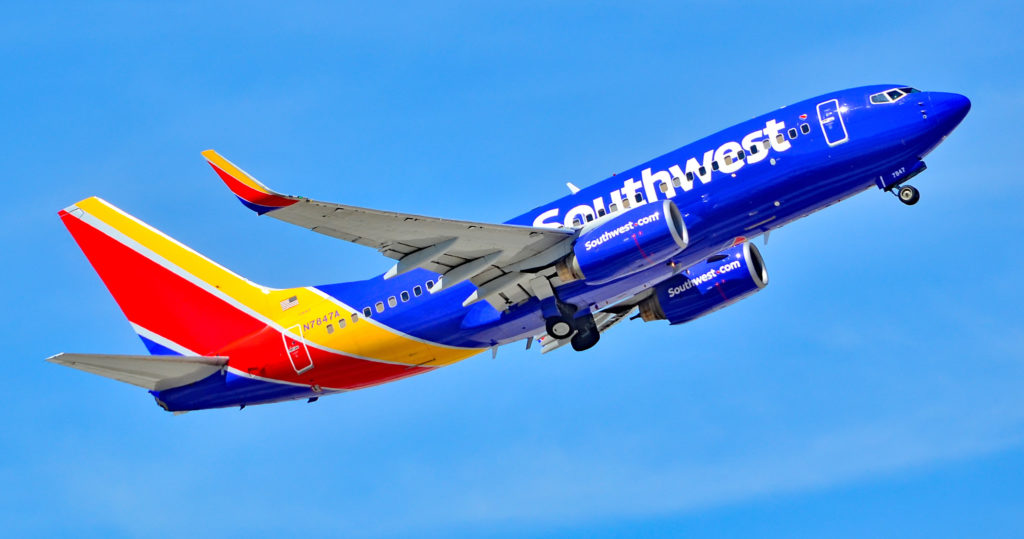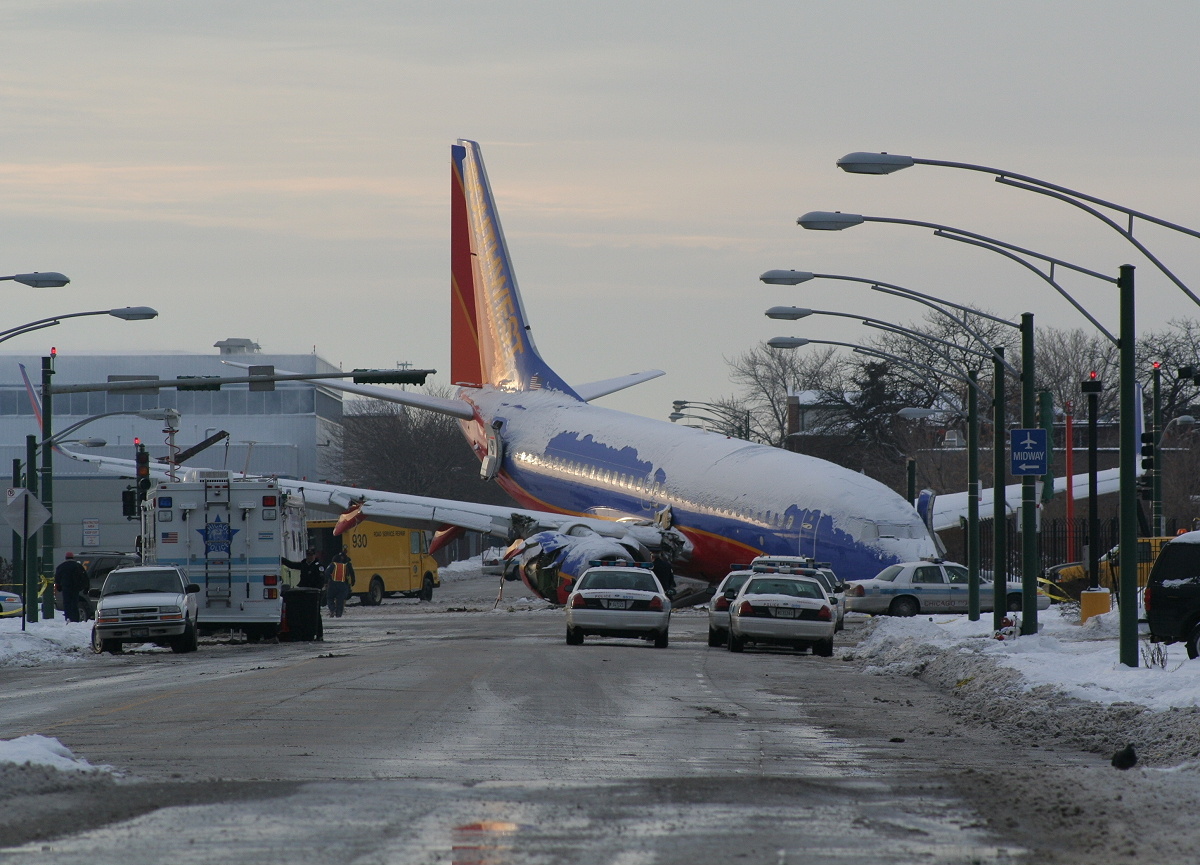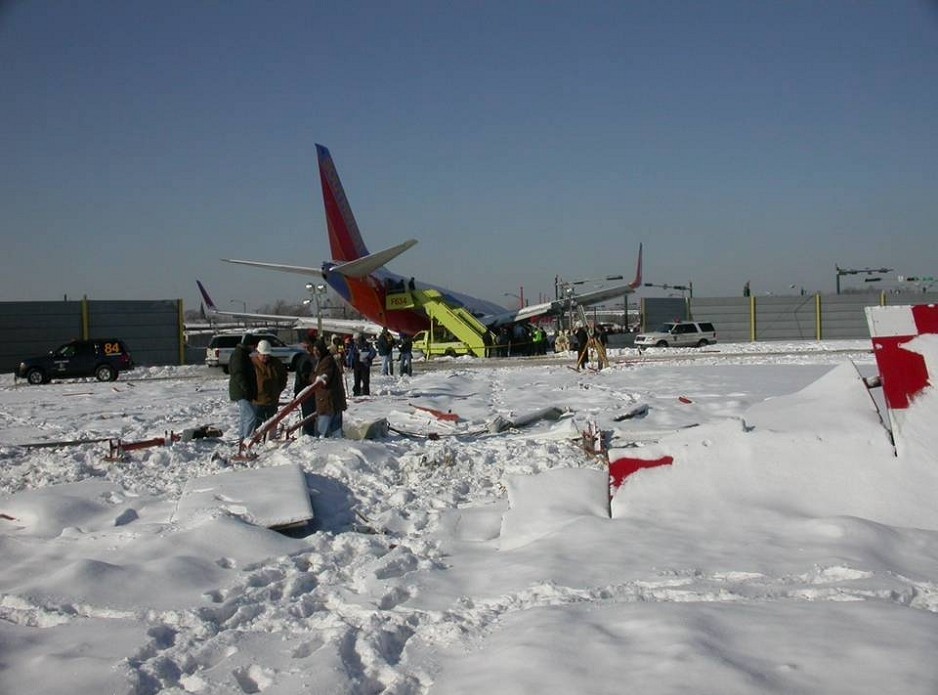08 December 2005 - Southwest 1248
Southwest Airlines Flight 1248 (WN1248, SWA1248) was a scheduled passenger flight from Baltimore-Washington International Airport, in Baltimore, Maryland, to Chicago Midway International Airport, in Chicago, Illinois, to Salt Lake City International Airport in Salt Lake City, Utah, and then to McCarran International Airport in Las Vegas, Nevada. On December 8, 2005. The flight circled over a small area in northwest Indiana several times before attempting to land in a snowstorm. The snowstorm had reduced visibility to less than one mile. The airplane slid off the runway at Chicago-Midway and crashed into automobile traffic, killing six-year-old Joshua Woods.

At around 7:15 p.m. CST, the pilot attempted a landing with nearly eight inches of snow on the ground in the area. Airport officials stated that the runway was cleared of snow prior to the time of landing. The latest reported weather had the wind from between east and east-southeast (100°) at 11 knots (20 km/h).
An east south easterly wind would normally favor landing into the wind on Runway 13 Center. The runway visual range was reported at 4,500 feet, below the landing minimums for the Instrument Landing System approach to Runway 13C. The only available runway with lower minimums was the opposite direction on 31C, with the aircraft's groundspeed consequentially boosted by the tailwind. Alternately, the crew could have held in the air, waiting for the weather to improve, or they could have diverted to another airport, such as Chicago O'Hare International, whose substantially longer runways were 10 minutes' flying time away. Each of these options would have entailed considerable additional expense for Southwest, as well as missed connections and significant inconvenience for the flight's passengers. The National Transportation Safety Board identified the psychological pressure to complete their assigned task as one of the factors contributing to the crew's decision to land at Midway despite unfavorable conditions. Cockpit voice-recorder transcripts indicate the pilots had been concerned about the weather and, prior to landing, jokingly alluded to the movie Airplane!, saying "I picked a bad day to stop sniffin' glue."
The NTSB preliminary report has determined that the aircraft touched down in the touchdown zone of the runway with 4,500 feet of its 6,522-foot (1,988 m) length remaining; under the prevailing conditions of weather, wind, speed, and weight, the aircraft needed 5,300 feet of runway to stop safely.

A preliminary NTSB advisory says: "The flying pilot (Captain) stated that he could not get the reverse thrust levers out of the stowed position. The first officer, after several seconds, noticed that the thrust reversers were not deployed, and activated the reversers without a problem. Flight data recorder information reveals that the thrust reversers were not deployed until 18 seconds after touchdown, at which point there was only about 1,000 feet of usable runway remaining."
The 737 skidded during landing; subsequently, witnesses said the nosegear collapsed, the aircraft crashed into a barrier wall surrounding the airport, and came to rest on South Central Avenue just south of the 55th Street intersection at the northwestern corner of the airport. The intersection was full of traffic, and the airplane hit at least three cars, killing a six-year-old boy named Joshua Woods, critically injuring five occupants of one car (two adults and three children), and seriously injuring four occupants of a second car. All were quickly taken to area hospitals. Three passengers from the aircraft were taken to hospitals with minor injuries. Twelve people were taken to hospitals after the incident. Another of the cars hit was parked and unoccupied.

The aircraft, a Boeing 737-700 with tail number N471WN, was delivered to Southwest in July 2004. As a "Next Generation" model, the 737 was equipped with the latest anti-skid and braking technology. The report noted that Southwest had only very recently begun actually using the autobrake systems, and that pilot training on proper use of auto brakes had been inadequate.
The National Transportation Safety Board was reported to be investigating, and Chicago Fire Department Commissioner Cortez Trotter said the aircraft would not be removed from the intersection until the NTSB gave clearance to do so following its on-site investigation. The nose of the aircraft was hoisted onto a flatbed tractor-trailer on Saturday, December 10, and the 737 was towed to a hangar for continued inspection.
It is now recommended practice for any new runway to have a clear area at least 1,000 feet (300 m) long at each end, called a 'runway safety area', to allow additional space for an aircraft that overruns the runway to decelerate and stop in relative safety. As Midway was constructed before these rules were put in place, it does not have this safety area. The accident renewed debates on the need for, and feasibility of, an engineered materials arrestor system, or EMAS, at Chicago Midway, given the lack of adequate overrun areas, and the surrounding residential neighborhoods. Additionally, actions taken by the city to acquire land for a buffer zone around the airport (in apparent recognition of the hazard) came to light after the crash. In 2007, installation began on modified, short-length arrestor beds. The first one was completed at the end of Runway 31C by summer 2007.
The accident occurred 33 years to the day after United Airlines Flight 553, also a Boeing 737, crashed while approaching Midway Airport, killing 45.
The accident involving Flight 1248 was the first Southwest Airlines accident in the 35-year history of the company to result in a fatality. The previous major incident was in 2000 when Southwest Airlines Flight 1455 overran a runway at Burbank, California, injuring 43 and narrowly avoiding a catastrophe; the aircraft ended up outside a Chevron gas station. Although the Midway accident killed a person on the ground rather than a passenger or crew member, Southwest followed the tradition of retiring any flight number involved in a fatal crash; current flights from Baltimore to Chicago departing at or around 3:55 PM are now designated Flight 1885. Southwest also petitioned the FAA in July 2006 to have the tail number of the aircraft changed to N286WN. After a lengthy repair, the aircraft emerged from Southwest's Midway hangar as N286WN in September 2006.
Download the Cockpit Voice Recorder transcript


